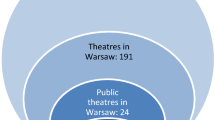Abstract
Performing arts groups’ performance is a focused issue. Use method of DEA-Malmquist productivity index to evaluate these groups’ performance in 2003–2011. Results show that although with progressive performing technology, our performing arts groups’ total factor productivity (TFP) has grown by 2.8 %, there are highlight problems of depending on governmental subsidy and support excessively, inadequate risk resistance capacity and unbalanced development. So these groups should emancipate and develop productivity, deepen internal system reform, enhance management level and self-financing rate and promote coordinated development of performing arts groups of diversified ownership, different levels and different types.
Access this chapter
Tax calculation will be finalised at checkout
Purchases are for personal use only
Similar content being viewed by others
References
Coelli T (1996) A guide to DEAP version 2.1: a data envelopment analysis (computer) program. CEPA Working Paper 96/08, University of New England, Australia
Deng H, Yan Z (2006) Application of dea method on analyzing the economic development of each city of hubei province. J Huaihua Univ 25(5):17–19 (In Chinese)
Guo G, Zheng S (2009) The evaluation and research of developmental performance in six provinces of central china’s culture industry china industrial. Economics 12:76–85 (In Chinese)
Lan Y, Han X (2011) The efficiency’s present situation and the evaluation of the dynamic efficiency of china’s art performance groups value. Engineering 23:9–11 (In Chinese)
Liu Z, Ye Q (2006) Comparison analysis on TFP of high technology industry in our country’s east-central-west regions—based on nonparametric Malmquist Index method. High-Technol Industrialization 4:22–24 (In Chinese)
Malmquist S (1953) Index numbers and indifference surfaces. Tra-bajos de Esladisica 4:209–232
Meng L, Gu H (2001) Nonparametric method of measuring productivity change. J Quant Tech Econ 2:48–51 (In Chinese)
National Burea of Statistics of China. China Statistical Yearbook (EB/OL). http://www.stats.gov.cn/tjsj/ndsj/
Plan and Financial Secretary. The analysis of the developing situation of national performing arts groups in recent years (EB/OL). http://www.ccnt.gov.cn. Accessed 23 Aug 2011
Sheng Z (1996) DEA theory, method and application. Science Press, Beijing (In Chinese)
Wang J, Zhang R (2009) The efficiency study of cultural industry in 31 provinces of China based on three stages DEA model. China Soft Sci Mag 9:75–82 (In Chinese)
Wei Q (1988) DEA method to evaluate the relative effectiveness—new field of operational research. China Renmin University Press, Beijing (In Chinese)
Acknowledgments
We gratefully acknowledge the research support received from the National Natural Science Fund (71173150), the Key Project of the National Social Science Fund (12AZD018), Program for New Century Excellent Talents in University (NCET-12-0389) and the key project of System Science and Enterprise Development Center of Sichuan Province (XQ12A01).
Author information
Authors and Affiliations
Corresponding author
Editor information
Editors and Affiliations
Rights and permissions
Copyright information
© 2014 Springer-Verlag Berlin Heidelberg
About this paper
Cite this paper
Huang, X., Yang, Y., Zhong, L. (2014). Performance Evaluation of China’s Performing Arts Groups from the Perspective of Totality and Subdivision. In: Xu, J., Cruz-Machado, V., Lev, B., Nickel, S. (eds) Proceedings of the Eighth International Conference on Management Science and Engineering Management. Advances in Intelligent Systems and Computing, vol 281. Springer, Berlin, Heidelberg. https://doi.org/10.1007/978-3-642-55122-2_93
Download citation
DOI: https://doi.org/10.1007/978-3-642-55122-2_93
Published:
Publisher Name: Springer, Berlin, Heidelberg
Print ISBN: 978-3-642-55121-5
Online ISBN: 978-3-642-55122-2
eBook Packages: EngineeringEngineering (R0)




